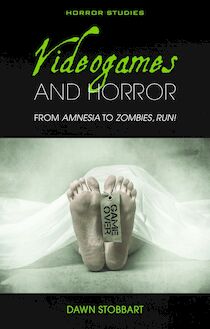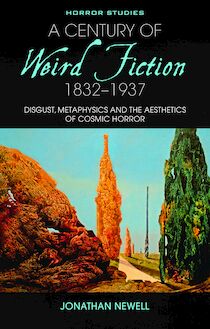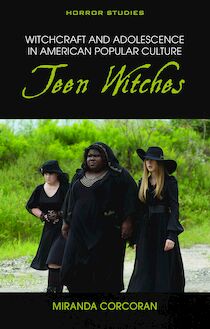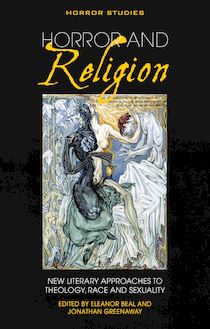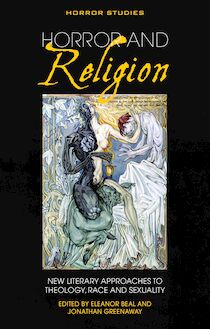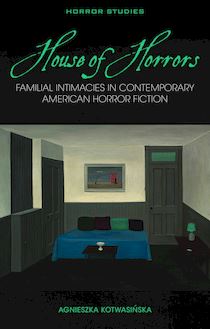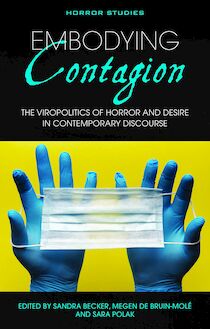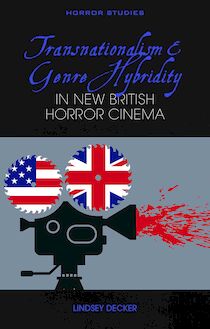-
 Univers
Univers
-
 Ebooks
Ebooks
-
 Livres audio
Livres audio
-
 Presse
Presse
-
 Podcasts
Podcasts
-
 BD
BD
-
 Documents
Documents
-
- Cours
- Révisions
- Ressources pédagogiques
- Sciences de l’éducation
- Manuels scolaires
- Langues
- Travaux de classe
- Annales de BEP
- Etudes supérieures
- Maternelle et primaire
- Fiches de lecture
- Orientation scolaire
- Méthodologie
- Corrigés de devoir
- Annales d’examens et concours
- Annales du bac
- Annales du brevet
- Rapports de stage
La lecture à portée de main
Vous pourrez modifier la taille du texte de cet ouvrage
Découvre YouScribe en t'inscrivant gratuitement
Je m'inscrisDécouvre YouScribe en t'inscrivant gratuitement
Je m'inscrisEn savoir plus
Vous pourrez modifier la taille du texte de cet ouvrage
En savoir plus

Description
*Rape-Revenge Films: A Critical Study McFarland 2011
* Found Footage Horror Films:
Fear and the Appearance of Reality McFarland 2014
* Suspiria Auteur Books 2015
* Ms. 45 Columbia University Press/ 2017
Wallflower
* The Hitcher Arrow Books 2018
1000 Women in Horror Bear Manor Media 2019 (forthcoming)
Editor of the following collections:
- Wonderland (Thames & Hudson/Australian Centre for the Moving Image)
Co-edited with Emma McRae, 2018
- Cattet & Forzani (Queensland Film Festival)
Co-edited with John Edmond, 2018.
- Routledge Handbook of Interdisciplinary Research Methods (Routledge)
Co-edited with Celia Lury, Rachel Fensham, Sybille Lammes, Angela Last, Mike Michael, and Emma Uprichard, 2018.
- ReFocus: The Films of Elaine May (Edinburgh University Press)
Co-edited with Dean Brandum. Due for July 2019 release.
Book Chapters (Selected)
- "Anti-Auteur: The Films of Roberta Findlay", in The Routledge Companion to Cult Cinema, edited by Ernest Mathjis and Jamie Sexton. London: Routledge (Forthcoming)
- "New Media Horror: Marble Hornets (2009 - 2014)", in The Horror Reader, edited by Simon Bacon. Berg Publishing (Forthcoming).
- "Chaos Made Flesh: Mr Sardonicus (1961) and the Mask as Transformative Device." In ReFocus: The Films of William Castle, edited by Murray Leeder. Edinburgh: Edinburgh University Press (Forthcoming).
- "Elaine May as Actor: On-Screen Performance and Embodied Collaboration", in ReFocus: The Films of Elaine May. Edinburgh University Press (UK). (Forthcoming).
- "Dangerous Business - The Life, Death and Rebirth of Ishtar (Elaine May, 1987)", in ReFocus: The Films of Elaine May. Edinburgh University Press (UK). Co-written with Dean Brandum. (Forthcoming).
- "The Omnipresent Alice", in Wonderland: Alice in Wonderland in Film, edited by Emma McRae and Alexandra Heller-Nicholas. Australian Centre for the Moving Image/Thames & Hudson. (Forthcoming).
- "Marilyn Manson’s Unmade Phantasmagoria: The Visions of Lewis Carroll", in Wonderland: Alice in Wonderland in Film, edited by Emma McRae and Alexandra Heller-Nicholas. Australian Centre for the Moving Image/Thames & Hudson. (Forthcoming).
- "Making and Assembling: Towards a Conjectural Paradigm for Interdisciplinary Research" in The Routledge Handbook of Interdisciplinary Research Methods, edited by Celia Lury. Co-written with Rachel Fensham. London: Routledge. (Forthcoming).
- "Seductive Kindness: Power, Space and ‘Lesbian’ Vampires". In Letting the Wrong One In: Hospitality, Rape and Consent in Vampire Popular Culture, edited by David Baker, Stephanie Green, Agnieszka Stasiewicz-Bieńkowska. London: Palgrave, 2017.
- "Horrific Transformations: Costume, Gender, and the Halloween Franchise". In Fashioning Horror: Dressing to Kill in Film and Literature, edited by Julia Petrov and Gundran Whitehead. New York: Bloomsbury, 2017. Co-authored with Nadia Buick.
- "Les deìmoniaques: Politics, Poetry, and the Supernatural Rape-Revenge Film", in Lost Girls: The Phantasmagorical Cinema of Jean Rollin, edited by Samm Deighan. Montréal: Spectacular Optical, 2017.
- "Fostering Evil: Adoption Stigma and the Monster Child in Film", co-authored with Craig Martin. In Misfit Children: An Inquiry into Childhood Belongings, edited by Markus P. J. Bohlmann. Lanham: Lexington, 2016.
- "From Opera House to Grindhouse and Back Again" in Grindhouse: Cultural Exchange on 42nd Street, and Beyond, edited by Austin Fisher and Johnny Walker London: Bloomsbury, 2016.
- "Against Adult Knowledge: Wisdom and Age in Deep Red". Dario Argento’s Deep Red, edited by Luciano Curreri and Michel Delville. Co-written with Craig Martin. Rome: Il Foglio Letterario / Centre Interdisciplinaire de Poetique Appliquee (Universite de Liege), 2015.
- "Bill Henson and the Polemics of the Nude Child in Photography", in The Culture of Photography in Public Space, edited by Anne Marsh, Melissa Miles, and Daniel Palmer. Co-written with Professor Anne Marsh. Bristol: Intellect, 2015.
- "Remembering Michelle Remembers", in Satanic Panic: Pop-Cultural Paranoia in the 1980s, edited by Kier-La Janisse and Paul Corupe. Montreal: Spectacular Optical, 2015 (republished by FAB Press in 2016).
- "The Devil Down Under: Satanic Panic in Australia from Rosaleen Norton to Alison’s Birthday", in Satanic Panic: Pop-Cultural Paranoia in the 1980s, edited by Kier-La Janisse and Paul Corupe. Montreal: Spectacular Optical, 2015 (republished by FAB Press in 2016).
- "Nicoletta Elmi: Italian Horror’s Imp Ascendant", in Kid Power! Ed. by Kier-La Janiesse. Co-written with Craig Martin. Montréal: Spectacular Optical, 2014.
- "’The Power of Christ Compels You’: Moral Spectacle and The Exorcist Universe" in Roman Catholicism in Fantastic Film: Essays on Belief, Spectacle, Ritual and Imagery, edited by Regina Hansen. Jefferson: McFarland & Co., 2011.
Entries in Reference Works
- Directory of World Cinema: Britain (Volume 2). Edited by Neil Mitchell. Entries on Hardware, Submarine, Tiger Bay, Raw Meat, The Railway Children and X: The Unknown. Bristol: Intellect, 2015.
- World Film Locations: Sydney. Edited by Neil Mitchell. Entries on Starstruck, The Tunnel, The Last Days of Chez Nous and The Last Wave. Essay on director Brian Trenchard-Smith. Bristol: Intellect, 2014.
- World Film Locations: Melbourne. Edited by Neil Mitchell. Entries on Alvin Purple, Thirst and Patrick. Bristol: Intellect, 2012.
Journal Articles (Peer Reviewed)
- "Ghostwatch: Supernatural and Technological Presence in Early 1990s Britain", Journal of Supernatural Studies 2 (Winter 2015).
- "The House of the Screaming Child: Ambivalence and the Representation of Children in Profondo Rosso (Dario Argento 1975)" (co-authored with Craig Martin) Red Feather Journal 4.2 (Fall 2013).
- "Cannibals and Other Impossible Bodies: Il Profumo Della Signora in Nero and the Giallo film", Scope: An Online Journal for Film and Television Studies 22, 2012.
- "The Violation of Representation: Art, Argento and the Rape-Revenge Film," Forum 13, 2011.
- "Silence and Fury: Rape and The Virgin Spring," Screening the Past 28, 2010.
- "Subversive Frames: Vermeer and Lucio Fulci’s Sette note in nero", Refractory: A Journal of Entertainment Media 17, 2010.
- "Snuff Boxing: Rethinking the Snuff (1976) Coda", Cinephile: The University of British Columbia Film Journal 5.2, 2009.
- "Last Trope on the Left: Rape, Film and the Melodramatic Imagination." Limina: A Journal of Historical and Cultural Studies 15, 2009.
Why has the mask been such an enduring generic motif in horror cinema? This book explores its transformative potential historically across myriad cultures, particularly in relation to its ritual and mythmaking capacities, and its intersection with power, ideology and identity. All of these factors have a direct impact on mask-centric horror cinema: meanings, values and rituals associated with masks evolve and are updated in horror cinema to reflect new contexts, rendering the mask a persistent, meaningful and dynamic aspect of the genre’s iconography. This study debates horror cinema’s durability as a site for the potency of the mask’s broader symbolic power to be constantly re-explored, re-imagined and re-invented as an object of cross-cultural and ritual significance that existed long before the moving image culture of cinema.
Acknowledgements
Introduction - Why Masks? Ritual, Power and Transformation
Chapter One: Situating Masks and Horror Cinema
Part One: Masks, Horror and Cinema: Towards Codification
Chapter Two: Masks and Horror in Literary and Performance Traditions and Early Cinema
Chapter Three: Masks in Horror Film Before 1970
Part Two: Horror Film Masks from 1970
Chapter Four: Skin Masks: Ritual, Power and Transformation
Chapter Five: Blank Masks: Ritual, Power and Transformation
Chapter Six: Animal Masks: Ritual, Power and Transformation
Chapter Seven: Repurposed Masks: Ritual, Power and Transformation
Part Three: Masks as Transformational Technologies – Moving Forward By Looking Back
Chapter Eight: Technological Masks: Ritual, Power and Transformation
Conclusion
Bibliography
Sujets
Informations
| Publié par | University of Wales Press |
| Date de parution | 15 octobre 2019 |
| Nombre de lectures | 0 |
| EAN13 | 9781786834980 |
| Langue | English |
Informations légales : prix de location à la page 0,2850€. Cette information est donnée uniquement à titre indicatif conformément à la législation en vigueur.
Extrait
Masks
IN HORROR CINEMA
HORROR STUDIES
Series Editor
Xavier Aldana Reyes, Manchester Metropolitan University
Editorial Board
Stacey Abbott, Roehampton University
Linnie Blake, Manchester Metropolitan University
Harry M. Benshoff, University of North Texas
Fred Botting, Kingston University
Steven Bruhm, Western University
Steffen Hantke, Sogang University
Joan Hawkins, Indiana University
Agnieszka Soltysik Monnet, University of Lausanne
Bernice M. Murphy, Trinity College Dublin
Johnny Walker, Northumbria University
Preface
Horror Studies is the first book series exclusively dedicated to the study of the genre in its various manifestations – from fiction to cinema and television, magazines to comics, and extending to other forms of narrative texts such as video games and music. Horror Studies aims to raise the profile of Horror and to further its academic institutionalisation by providing a publishing home for cutting-edge research. As an exciting new venture within the established Cultural Studies and Literary Criticism programme, Horror Studies will expand the field in innovative and student-friendly ways.
Masks
IN HORROR CINEMA
EYES WITHOUT FACES
ALEXANDRA HELLER-NICHOLAS
© Alexandra Heller-Nicholas, 2019
All rights reserved. No part of this book may be reproduced in any material form (including photocopying or storing it in any medium by electronic means and whether or not transiently or incidentally to some other use of this publication) without the written permission of the copyright owner except in accordance with the provisions of the Copyright, Designs and Patents Act. Applications for the copyright owner’s written permission to reproduce any part of this publication should be addressed to the University of Wales Press, University Registry, King Edward VII Avenue, Cardiff, CF10 3NS.
www.uwp.co.uk
British Library Cataloguing-in-Publication Data
A catalogue record for this book is available from the British Library.
ISBN 978-1-78683-496-6
eISBN 978-1-78683-498-0
The right of Alexandra Heller-Nicholas to be identified as author of this work has been asserted in accordance with sections 77 and 79 of the Copyright, Designs and Patents Act 1988.
The publisher has no responsibility for the persistence or accuracy of URLs for any external or third-party internet websites referred to in this book, and does not guarantee that any content on such websites is, or will remain, accurate or appropriate.
Cover image: Eyes without a Face, dir. Georges Franju (Lux Film, 1960), poster.
PictureLux / The Hollywood Archive / Alamy Stock Photo.
For Casper and Christian
Contents
Acknowledgements
Introduction
1. Situating Masks and Horror Cinema
Part One: Masks, Horror and Cinema – Towards Codification
2. Masks and Horror in Literary and Performance Traditions and Early Cinema
3. Masks in Horror Film before 1970
Part Two: Horror Film Masks from 1970 – Case Studies
4. Skin Masks: Ritual, Power and Transformation
5. Blank Masks: Ritual, Power and Transformation
6. Animal Masks: Ritual, Power and Transformation
7. Repurposed Masks: Ritual, Power and Transformation
Part Three: Masks as Transformational Technologies – Moving Forward by Looking Back
8. Technological Masks: Ritual, Power and Transformation
Conclusion
Endnotes
Bibliography
Acknowledgements
W ITH A PROJECT of this scale there are of course many people to thank. First, I must acknowledge Angela Ndalianis without whose practical and emotional support this would never have got off the ground, let alone ever be finished. Many thanks to the Horror Studies series editor Xavier Aldana Reyes and Sarah Lewis at University of Wales Press for the privilege of inviting me to join the series, and for their unceasing warmth, support and encouragement. I would also like to thank Stephen Morgan for his assistance in sourcing the Abel Gance documentation vital to chapter 2, as well as Julien Allen, Franck Boulègue and Samuel Bréan for their translation assistance of this material, and to Kevin Heffernan and Mark Jancovich for their invaluable feedback on the original thesis version of this book. Josh Nelson went well above and beyond the call of duty on pretty much all fronts (including his impressive copy-editing prowess), and I would also like to thank the following for their support: Anton Bitel, Sally Christie, Anna Dzenis, John Edmond, Giles Edwards, Mark Freeman, Lee Gambin, Wendy Haslem, Jade Henshaw, Ian Gouldstone, Anne Marsh, Craig Martin, Jan Napiorkowski, Tim O’Farrell, David Surman and Emma Westwood. As always, thanks to my family, Richard, Lorraine, Max, Fiona and Robert, and with particular love and gratitude to Casper and Christian.
Introduction
L ITTLE IS KNOWN of mononymous Belarusian film director Makinov, director of Come Out and Play , the 2012 Mexican remake of the Spanish horror classic Who Can Kill a Child? ( ¿Quién puede matar a un niño? , Narciso Ibáñez Serrador, 1976). While masks have long been an iconographic staple of horror cinema, Makinov took this generic fascination to its logical extreme: not only did he promote the film wearing a crude red sack mask with eyeholes cut out, but the cast and crew of Come Out and Play allegedly never saw his face during the production itself. 1 In a video introduction to a 2012 Toronto International Film Fest screening of Come Out and Play , Makinov said ‘I wear my mask because through anonymity I can be all I want. As a beloved writer says, I believe in my mask, the man I made up is me. I believe in my dance and my destiny.’ 2 Through this reference to Sam Shepard’s The Tooth of Crime (1972), this horror film-maker made clear his belief that there is a meaningful connection between power, creativity and identity. Whether a publicity stunt or a material manifestation of his aesthetic philosophy, this is a memorable instance of the potency of horror film masks being deployed beyond the fictional constraints of cinema to make a statement.
As a horror film-maker, Makinov’s mask consciously evokes a long history. Masks are closely linked to the horror legacies of icons like Lon Chaney Sr. and Vincent Price and in slasher franchises like Friday the 13th (1980–2009) and Halloween (1978–2018). When used diegetically, horror film masks imply associations with broader notions of identity and there are complexities embedded in how they are both deployed and are understood over time: their symbolic potency as objects linked to ritual, power and transformation has evolved over history. The conceptual force of horror film masks stems from both its generic ubiquity and simultaneous status as a cross-cultural associated with a complex range of historically defined meanings and values. These meanings and values are constantly evolving in horror to reflect new cultural and ideological contexts, rendering masks a persistent and important element of the genre’s iconography. There is a crucial tension at play across the history of horror film masks between variation and consistency: while the mask is itself an enduring element of the genre, the meanings and values attached to it are demonstrably dynamic and adaptable.
From the outset, it must be stated that horror masks are not specific to only feature-length horror films, and horror narratives and media experiences across television and videogames are themselves worthy of future discussion and exploration, spanning as they do from a long literary history where masks and horror intersect (that will be discussed elsewhere in this book). The focus here, however, is specifically on horror feature films as they have a much longer history as a screen phenomenon that privileges masks. It thus can inform future examinations of other media, be it in terms of how it overlaps or – just as significantly – how it deviates. Horror film masks are a continuation of a multifaceted historical trajectory, their transformative potential continuing ritualistic and myth-making processes linked both to power, ideology and identity (as seen across myriad cultures with a recorded history of privileging this object) and also to genre itself. Horror film masks provoke associations with disguise and anonymity with a predominantly narrative purpose: to obscure – then possibly expose – the identity of a killer. Yet this reduces the utility of horror film masks to purely one of revelation and occlusion. While not untrue, often in horror movies we know the identity of the mask wearer: there is, for instance, no mystery about the Halloween franchise’s slasher killer Michael Myers or that of the Friday the 13th films, Jason Voorhees. To conceive horror film masks solely as anonymity-creating devices undermines the power of the objects themselves. Even in their earliest, supposedly ‘primitive’ usages, masks were often bestowed with great power in terms of spiritual belief across a range of religious practices. This power is linked closely to masks as transformative devices.
Focusing on the intersection of ritual (be it secular or religious), power and transformation, we can see that horror cinema is a durable forum for the enduring potency of the mask’s broader symbolic power to be constantly re-explored, re-imagined and re-invented, continuing key aspects of its cross-cultural and ritual significance that existed long before moving image culture. While there have been numerous critical examinations of horror film masks in specific movies, franchises, national and subgeneric contexts, there remains a broad absence of any substantial critical research dedicated to horror film masks and how they intersect with cultural histories of masks more broadly. We can employ this past research to assist building the foundations of a focused, critical analysis of horror film masks, synthesising and expanding upon these scattered treatments to map a cultural history of horror film masks, focusing specifically on ritual, power and transformation.
Chapter 1 expands on
-
 Univers
Univers
-
 Ebooks
Ebooks
-
 Livres audio
Livres audio
-
 Presse
Presse
-
 Podcasts
Podcasts
-
 BD
BD
-
 Documents
Documents
-
Jeunesse
-
Littérature
-
Ressources professionnelles
-
Santé et bien-être
-
Savoirs
-
Education
-
Loisirs et hobbies
-
Art, musique et cinéma
-
Actualité et débat de société
-
Jeunesse
-
Littérature
-
Ressources professionnelles
-
Santé et bien-être
-
Savoirs
-
Education
-
Loisirs et hobbies
-
Art, musique et cinéma
-
Actualité et débat de société
-
Actualités
-
Lifestyle
-
Presse jeunesse
-
Presse professionnelle
-
Pratique
-
Presse sportive
-
Presse internationale
-
Culture & Médias
-
Action et Aventures
-
Science-fiction et Fantasy
-
Société
-
Jeunesse
-
Littérature
-
Ressources professionnelles
-
Santé et bien-être
-
Savoirs
-
Education
-
Loisirs et hobbies
-
Art, musique et cinéma
-
Actualité et débat de société
- Cours
- Révisions
- Ressources pédagogiques
- Sciences de l’éducation
- Manuels scolaires
- Langues
- Travaux de classe
- Annales de BEP
- Etudes supérieures
- Maternelle et primaire
- Fiches de lecture
- Orientation scolaire
- Méthodologie
- Corrigés de devoir
- Annales d’examens et concours
- Annales du bac
- Annales du brevet
- Rapports de stage
